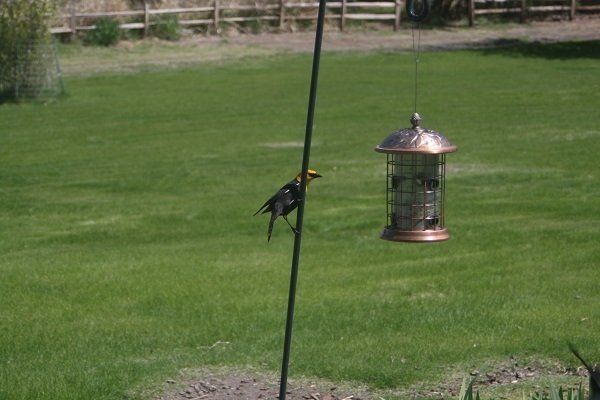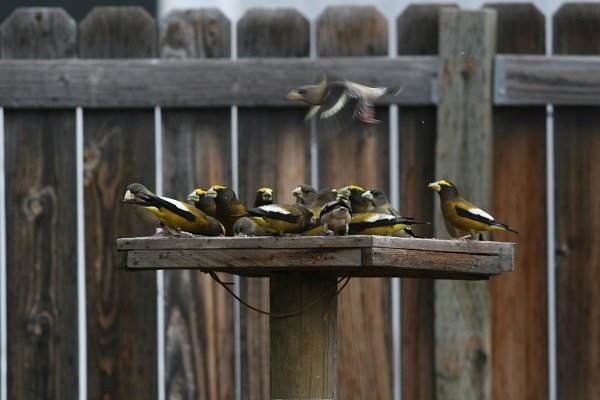





February is a month literally for the birds.
The top two popular outdoor activities for Americans are gardening at number one and bird watching at number two. Somewhere in the neighborhood of 40.5 million U.S. households participate in backyard birding and, I'll wager, a lot of those homes also contain gardeners. Far removed from the days of my mom tossing bread crumbs out the kitchen door for the birds, today's wild bird seed industry--including the sale of feeders, outdoor bird art, bird seed, landscaping and watering features--totals around $5.5 billion in North America. A lot of research and patient observers have analyzed which type of seeds wild birds eat. Project Wildbird was a North American study of seed and feeder preferences by wild birds. Over a 3-year span, over 200 people made numerous 45-minute long observations of bird activities at feeders. They recorded data as to the type of seed certain species were eating, and out of what type of feeder. The data ended up with over 1 million bird visits, so this wasn't just some weekend backyard project. The researchers concluded that there were 5 main types of seed that birds preferred out of 10 different ones. Black-oil sunflowers, sunflower chips (fine and medium), Nyjer thistle and white Proso millet were the top five. Also, the black-oil sunflower seed was selected by chickadees, nuth atches and larger finches, while smaller finches like siskins and goldfinches went for the Nyjer thistle. These smaller finches also preferred tube feeders with slits for feeding ports, not big openings. With their thin bills they could extract seeds that the thicker-billed birds could not. Although you can find the 20-lb bag of "wild bird seed" mix for $5 in discount stores, there are also premium mixes that might run you $40 for a 20-lb bag. Many of the cheaper mixes have fillers, red millet or corn that many birds ignore and spill from the feeder. This waste material might be consumed by ground feeding birds, but the waste also attracts mice and small rodents.To celebrate backyard bird feeding, February has been declared as National Bird Feeding Month by the National Bird-Feeding Society. This group is promoting the joy of backyard bird feeding and education of wild birds. Part of the education is learning what types of foods local birds consume and filling feeders accordingly. No sense putting out a lot of seed that the birds bypass. In my yard, I have a mix of tube and platform feeders and even an old hopper-style feeder that I love watching the grosbeaks land on. I fill the tube and hopper feeders with black-oil sunflower seeds and have several thistle seed feeders that attract pine siskins, lesser and American goldfinches. Sometimes the nuthatches try to get to the thistle, but they often give this up for the black-oil sunflowers or the dove and quail mix that I spread on the platform feeders. Although I do get house finches and sparrows sparring over the seed, when the California quail arrive they quickly consume the seedDuring the summer months I cut back on the bird seed and lure birds into the yard with nectar plants or others that either form seeds or fruits. Many of the plants also have insects on them which some birds will consume for the high protein content. I also hang a couple of hummingbird feeders which attract Annais and Rufuous hummingbirds.
atches and larger finches, while smaller finches like siskins and goldfinches went for the Nyjer thistle. These smaller finches also preferred tube feeders with slits for feeding ports, not big openings. With their thin bills they could extract seeds that the thicker-billed birds could not. Although you can find the 20-lb bag of "wild bird seed" mix for $5 in discount stores, there are also premium mixes that might run you $40 for a 20-lb bag. Many of the cheaper mixes have fillers, red millet or corn that many birds ignore and spill from the feeder. This waste material might be consumed by ground feeding birds, but the waste also attracts mice and small rodents.To celebrate backyard bird feeding, February has been declared as National Bird Feeding Month by the National Bird-Feeding Society. This group is promoting the joy of backyard bird feeding and education of wild birds. Part of the education is learning what types of foods local birds consume and filling feeders accordingly. No sense putting out a lot of seed that the birds bypass. In my yard, I have a mix of tube and platform feeders and even an old hopper-style feeder that I love watching the grosbeaks land on. I fill the tube and hopper feeders with black-oil sunflower seeds and have several thistle seed feeders that attract pine siskins, lesser and American goldfinches. Sometimes the nuthatches try to get to the thistle, but they often give this up for the black-oil sunflowers or the dove and quail mix that I spread on the platform feeders. Although I do get house finches and sparrows sparring over the seed, when the California quail arrive they quickly consume the seedDuring the summer months I cut back on the bird seed and lure birds into the yard with nectar plants or others that either form seeds or fruits. Many of the plants also have insects on them which some birds will consume for the high protein content. I also hang a couple of hummingbird feeders which attract Annais and Rufuous hummingbirds. I know that even in winter, feeding the wild birds is just supplementing their food resources. These birds are constantly searching for food and may return to the feeders if their searches are futile. Of course, the feeders also offer some danger, as predators key in on them to prey on the songbirds. But if there is enough vegetation that the songbirds can escape into, then their chances of survival are much higher. Just as there is a wide diversity of seed available, there are a range of feeder types that will also help to attract certain species. Long, cylindrical tube feeders may have large or tiny ports from which the birds extract seeds. The small NyjerÆ thistle seed has a special feeder so that the birds have to pull the seeds out one by one. There is minimal waste or dropped seed, and the larger finches canít access these ports with their thick bills. Some of the larger tube feeders also come with wire cages to reduce competition from larger birds and so that the smaller ones can feed in peace. Besides the tube feeders, there are hopper feeders that look like mini-pagodas or platform feeders that also attract ground feeders like dove and quail. I use a special dove and quail mix for these birds, and spread some on the ground away from the other feeders. Another specialty food is suet cakes and these come in a variety of blends with seeds, berries, insects or fruits. The square cakes fit nicely in a square wire suet feeder which has a wire chain so that the feeder can be hung from a tree limb or branch. Woodpeckers, nuthatches, jays and other birds visit these suet feeders for a high energy meal. Backyard bird feeding has come a long way from the days when my mother used to throw bread crumbs out into the yard for the birds. A lot of science and observation time has gone into making this a very productive industry and one where the watcher gains a tremendous amount of satisfaction as the birds come and go from their yard.
I know that even in winter, feeding the wild birds is just supplementing their food resources. These birds are constantly searching for food and may return to the feeders if their searches are futile. Of course, the feeders also offer some danger, as predators key in on them to prey on the songbirds. But if there is enough vegetation that the songbirds can escape into, then their chances of survival are much higher. Just as there is a wide diversity of seed available, there are a range of feeder types that will also help to attract certain species. Long, cylindrical tube feeders may have large or tiny ports from which the birds extract seeds. The small NyjerÆ thistle seed has a special feeder so that the birds have to pull the seeds out one by one. There is minimal waste or dropped seed, and the larger finches canít access these ports with their thick bills. Some of the larger tube feeders also come with wire cages to reduce competition from larger birds and so that the smaller ones can feed in peace. Besides the tube feeders, there are hopper feeders that look like mini-pagodas or platform feeders that also attract ground feeders like dove and quail. I use a special dove and quail mix for these birds, and spread some on the ground away from the other feeders. Another specialty food is suet cakes and these come in a variety of blends with seeds, berries, insects or fruits. The square cakes fit nicely in a square wire suet feeder which has a wire chain so that the feeder can be hung from a tree limb or branch. Woodpeckers, nuthatches, jays and other birds visit these suet feeders for a high energy meal. Backyard bird feeding has come a long way from the days when my mother used to throw bread crumbs out into the yard for the birds. A lot of science and observation time has gone into making this a very productive industry and one where the watcher gains a tremendous amount of satisfaction as the birds come and go from their yard.
Copyright © www.100flowers.win Botanic Garden All Rights Reserved